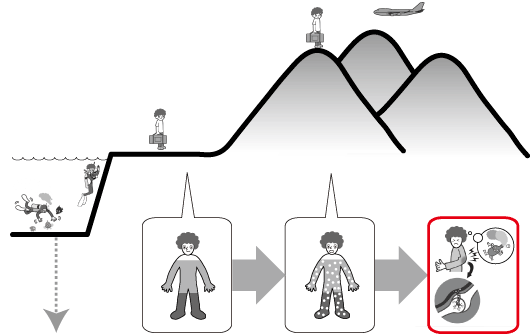 How to examine Time Until Safe To Fly after diving? How to examine Time Until Safe To Fly after diving?
|
In case of you board an airplane just after diving in the state that nitrogen is left in your body, bubble that is made by internal nitrogen causes Decompression Sickness so that pressure of the atmosphere decreases in an airplane.
Therefore, you cannot board an airplane just after diving. |
 |
Last diving |
Just after diving |
Boarding an airplane and movement to altitude |
As the Result ... |
|
In case of you board an airplane just after diving in the state that nitrogen is left in your body... |
Internal nitrogen becomes bubble so that pressure of the atmosphere decreases. |
Bubble causes Decompression Sickness. |
|
For boarding an airplane, you should know the safety time by using <Table
2> Surface Interval Time Table. |
 |
How long does it takes to board an airplane safely for Residual Group E diver? |
|
《The usage of Dive Table》
① The Residual Group at the time of the diving end was E.
You should trace the line and look at <Table 2> Surface Interval Time Table.
② Time Until Safe To Fly after diving is 24 hours.
|
|
a) Time Until Safe To Fly after diving |
 |
|
 |
Correct answer: 24 hours
You can board an airplane after 24 hours from the time at that you have finished diving. |
|
In case of you have dived several times within 36 hours, you should compare Time Until Safe To Fly after diving of each diving end and adopt the longest Time Until Safe To Fly after diving. |
 |
Time Until Safe To Fly after diving is 24 hours after the first diving.
You dived again after 1 hour 30 minutes Surface Interval Time.
How long does it takes to board an airplane safely in case of your Residual Group is F? |
|
《Dive table usage》
① The Residual Group at the time of the diving end was F.
You should trace the line and look at <Table 2> Surface Interval Time Table.
② The Time Until Safe To Fly after diving is 30 hours.
③ By the way, The Time Until Safe To Fly after diving is 24 hours for first diving.
④ As the second diving is performed within 36 hours from the first diving, you can board an airplane after 30 hours from the time at that you have finished second diving.
|
|
|
a) The Time Until Safe To Fly after first diving
b) The Time Until Safe To Fly after second diving |
 |
|
 |
Correct answer: 30 hours
As the second diving is performed within 36 hours from the first diving, you can board an airplane after 30 hours from the time at that you have finished second diving. |
|
 |
 |
Just after diving |
After the time until safe to fly after diving |
Boarding an airplane and movement to altitude |
After diving, let's stay till nitrogen disappears from your body. |
Nitrogen disappears from a body after The Time Until Safe To Fly after diving and; ... |
Let's board an airplane and move to altitude. |
|
 |
In case of you board an airplane or move to altitude without enough rest after diving, bubble that is made by internal nitrogen causes Decompression Sickness.
I recommend that boarding an airplane and movement to altitude should be done after long time rest regardless of the theoretical result from the dive table so that there is individual difference.
In addition, the Japanese researcher recommends that you should not board an airplane and move to altitude within 24 hours from the last diving.
In addition, The Time Until Safe To Fly after diving may be set in a rule for a diving point and an area. When it is set, let's use it.
For example, the guideline of The Time Until Safe To Fly after diving that is announced by International diving Specialized Agencies is below.
① 12 hours for diving once a day
② 18 hours for a few diving once a day or diving for a few day
③ More than 18 hours for a diving to need decompression |
|
*A dive table term*
■The Time Until Safe To Fly after diving
This is the time that is written in <Table 2> Surface Interval Time
Table.After this time, you can board an airplane. |
|
|

